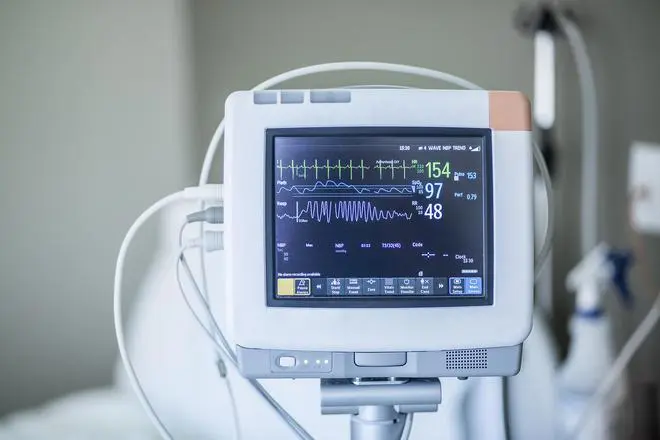Standing at the cusp of a new dawn for MedTech, India is at an inflexion point, where the sector is poised to “Aspire” and get ready for a quantum leap. The government is paving a new path for the accessibility of medical devices by placing the sector on accelerated growth, as envisioned in the approach paper on the draft National Medical Devices Policy 2022. We are looking at the future of MedTech with a holistic policy, giving the sunrise sector the much-needed impetus. These developments will strengthen India’s domestic and global MedTech value, as it is already among the top 20 markets for medical devices worldwide.
Related Stories
Turning green for health
FSSAI has also recognised vegan foods in a historic landmark decision and with a new logo (‘V’ with a plant on top, all in green) to help consumers recognise plant-based foods
Nearly 70 per cent of medical devices in India is imported (file image) | Photo Credit: Yobro10
The market is expected to increase at a 37 per cent CAGR. While those numbers paint a promising picture, India still relies 70% on imports for medical devices. For a country where MedTech combines large multinationals and small and midsized companies, the dependence on imports presents an opportunity for the crisis. Strengthening the Indian MedTech market calls for addressing the fundamentals – building better resilience for future contagions, self-reliance, and ability to handle patient volumes without compromising quality; enabling broader access to care and focusing on prevention with improved diagnostics, higher imaging intelligence and reducing radiation risk.
Related Stories
Securing health should have been a priority this Budget
The Centre’s focus on creating e-health records during the pandemic while neglecting the actual public healthcare delivery system is problematicCharting the path through collaborations
In 2020, the government announced incentivisation plans of at least ₹3,420 crore over five years for manufacturers who invest in set-ups to manufacture key medical devices. The Production Linked Incentives (PLI) Scheme for Medical Devices provides a much-needed boost to domestic manufacturing, making it globally competitive. A case in point, at GE Healthcare, we recently launched a Rs 100-crore unit under the government’s PLI scheme for local manufacturing of CT machines, cath lab equipment, ultrasound scanners, patient monitoring solutions, ECG machines and ventilators. The PLI scheme is attracting large investments in medical devices segments. With more participation from the industry, we can look at radiology, cancer care devices, and imaging devices becoming more accessible to people.
When we speak of collaboration, we saw its value as we witnessed the chip shortage period. MedTech companies should work closely with the governments when critical equipment is unavailable. The partnership will help ensure that public health is not affected, strengthen local manufacturing, and integrate chains domestically. We should use this time to boost local manufacturing and integrate the supply chain domestically.
Related Stories
Indian healthcare: Self-reliant, but in a global ecosystem
Why Indian healthcare must harmonise its standards with the rest of the worldLeveraging Data to Drive MedTech
This is where data comes into play.
According to the Covid Impact Assessment Study by GE in India in 2021, “60 per cent of the respondents felt that there will be an increased focus on adoption of AI based solutions over the next 3 years, 48% felt that there will be an increase in adoption of cloud-based healthcare solutions while 66% said that there will be a rise in digital transformation initiatives.”
We now have precision medicine and tools that use intelligence platforms to achieve patient outcomes and improve access to care. Integration and assimilation of data from disparate sources and applying advanced algorithms to generate operationally, and financial insights, the new tools have it all.
Building MedTech with Skilled Professionals
Another significant gap area continues to be ‘skill’. We have a lot of talent, but are they suitably trained and qualified for the highly precise work needed for med-tech? Under Pradhan Mantri Swasthya Suraksha Yojana (PMSSY), 22 new All India Institutes for Medical Science (AIIMS) and 75 Government Medical College up-gradation were constructed, and projects have been approved.
With Ayushman Bharat Health Infrastructure Mission, we have 157 new medical colleges, 16 AIIMS, and 37,000 beds. If the government and private sector could collaborate to invest in building better infrastructure like hospitals, diagnostic centres and mental health clinics, India will be able to make affordable and accessible healthcare a new reality for our people.
The future will demand stronger collaborations, smarter technology, and a deeper understanding of the policy ecosystem to drive value from MedTech. From setting up medical parks to partnering with the industry and academia, India is on its way to reducing its import dependency and making healthcare more accessible.
We are aspiring for tomorrow that promises quality healthcare to the last mile. The question is - how do we make it a reality?
The writer is Managing Director, Wipro GE Healthcare, and President, NATHEALTH. Views are personal





Comments
Comments have to be in English, and in full sentences. They cannot be abusive or personal. Please abide by our community guidelines for posting your comments.
We have migrated to a new commenting platform. If you are already a registered user of TheHindu Businessline and logged in, you may continue to engage with our articles. If you do not have an account please register and login to post comments. Users can access their older comments by logging into their accounts on Vuukle.